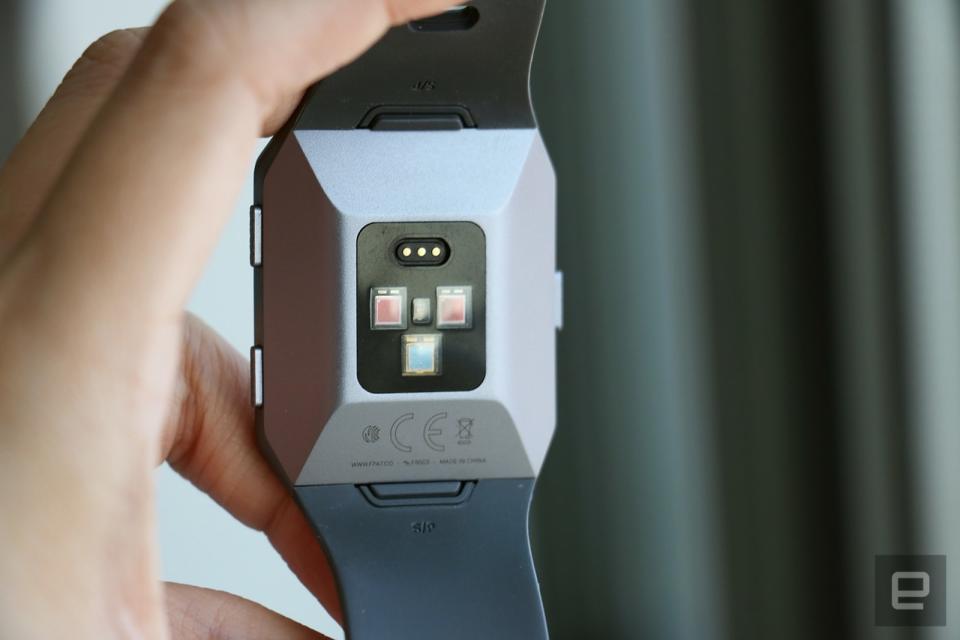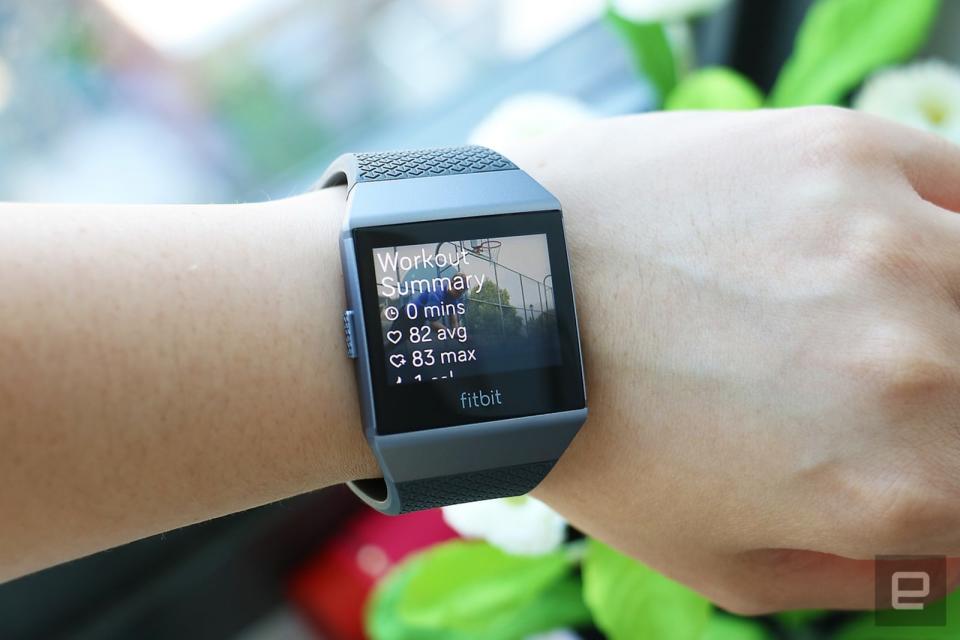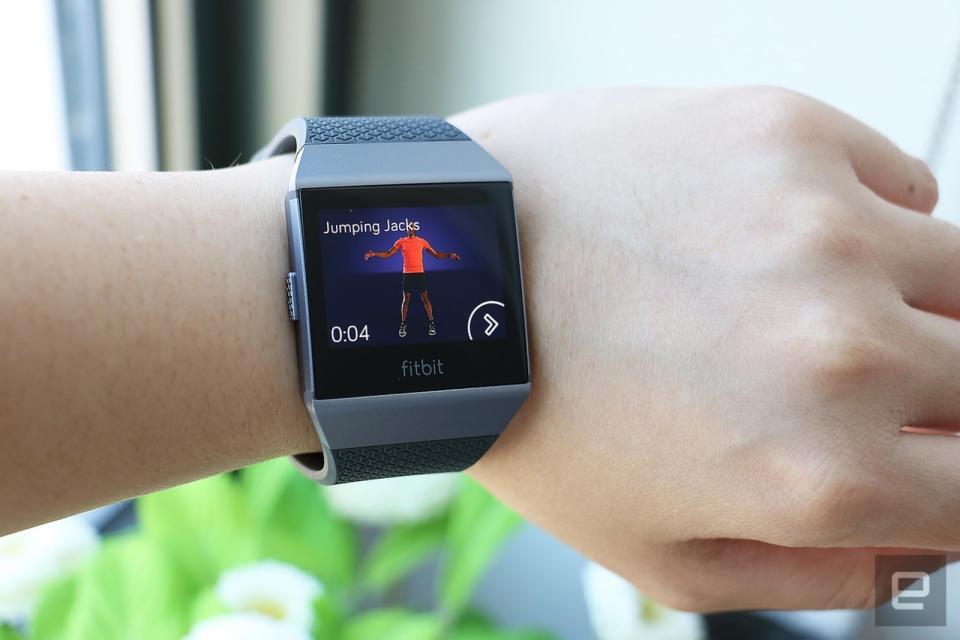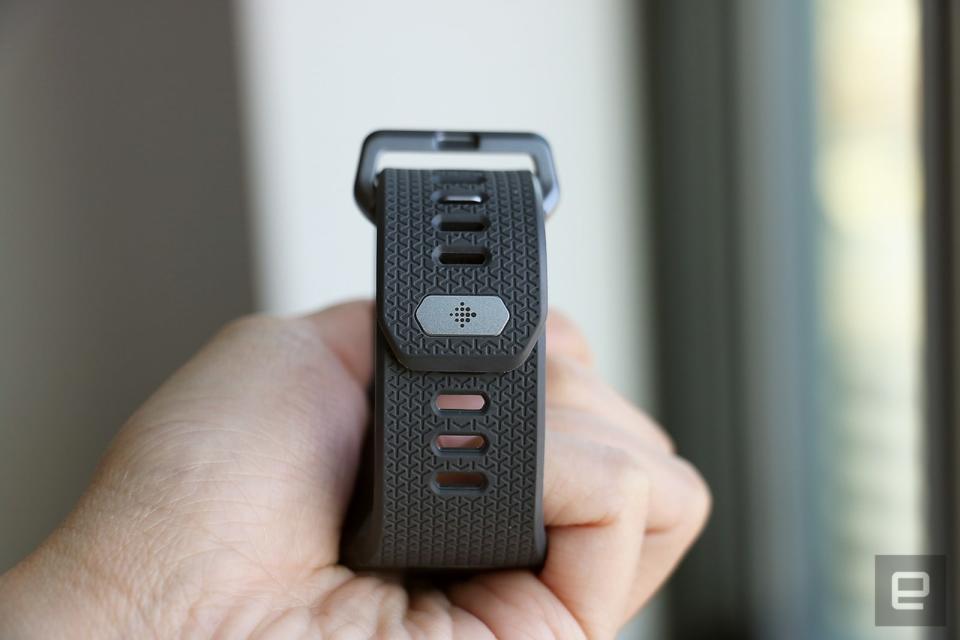Fitbit Ionic smartwatch hands-on: A surprisingly well-rounded debut
The company's first real smartwatch will cost $300.

After a series of reported delays and developmental challenges, Fitbit is finally ready to unveil its first smartwatch. The timing is appropriate, given that this is the tenth anniversary of the company's first tracker. The Ionic is Fitbit's most modern device to date, featuring a colorful LCD touchscreen and advanced sensors. It also serves as the launchpad for some new Fitbit services, like a fully fledged operating system called FitbitOS, contactless payment and a subscription-based custom workout guide called Fitbit Coach. The company needs the Fitbit Ionic to be successful -- its sales have slowed in recent months, and it faces a lawsuit over its use of haptic feedback. Judging from the few days I've had an early version of the Ionic, it appears to have the potential to resuscitate Fitbit's waning business.
Fitbit sees the Ionic as its flagship device, and naturally the company stuffed it full of features. In addition to a brilliant display, you'll get an updated heart rate monitor, a new SpO2 blood oxygen sensor (more on that later), onboard GPS and NFC. That last component enables the new Fitbit Pay service, which will be accepted anywhere Mastercard, Visa and Amex contactless payments are supported. I tried it out at a pop-up shop the company set up and was pleased with how easy the process was. I just had to hold down the left button until the image of the card appeared, then tap the watch face against the payment terminal. Loading a card on the watch is slightly tedious; you'll have to open Fitbit on your phone, find the Wallet app and enter your card number, name and address. It would be more convenient if Fitbit added the option to use your camera to scan those details from your card, but the existing system works fine.
I tested the Ionic's onboard GPS and water resistance when I took it to the pool one evening. Fitbit uses your location information to track laps, and this worked well during my brief test. The company's reps suggested I set my pool's length in the app before starting, but it didn't have an option for my relatively small (20–25 meters) facility. Still, I set it to 50 yards (the lowest available setting) and quickly swam four laps. I was pleasantly surprised when the Ionic calculated that I had clocked four and a half 20-meter laps -- quite accurate considering I had walked about halfway back before stopping the workout.

For now, it isn't clear how Fitbit intends to integrate the SpO2 sensor data. The optical system uses a combination of LEDs and a camera to detect your blood oxygen and calculate the relative rate of change. Fitbit says relative change in blood oxygen can be used to detect and understand sleep apnea, but that's something that will be implemented later.
Speaking of, the Ionic will also track your sleep the way previous Fitbits (like the Alta HR and Charge 2) do. The Ionic monitors your pulse and movement to see what stage of sleep (deep, REM, light, etc.) you're in throughout the night. My previous experience with the Alta HR wasn't the most assuring -- I sometimes woke up to find that the tracker hadn't registered my sleep stages at all, possibly due to the device's having moved while I slept.
To that end, Fitbit has designed the Ionic so that it sits more securely. Using a method the company calls nano-molding technology (NMT), the smartwatch curves slightly to hug your wrist. During my few days with the Ionic, I've found it more reliable and comfortable to wear to bed than the Alta HR. The new watch is more consistent in tracking my heart rate as I sleep, although it has gotten poorer at identifying when I doze off. For example, I went to bed at 1 AM one night, but the Ionic says I only fell asleep at 4:09 AM, which I know isn't true, since I remember briefly waking up at 4 AM. After I woke up at 7:45 AM, that put me at a dismal 3 hours and 14 minutes (counting the times I woke up) of sleep for the night. So far, this is a one-time fluke, but it messes up my metrics.

The Ionic also features a unibody design made from aerospace-grade aluminum and a "spherical glass" screen. The surface of the display is slightly curved, but I can barely tell that it is. Those who were hoping for a round screen will be disappointed; the Ionic is as blockish as the rest of Fitbit's devices. In fact, its rectangular panel, flanked by lugs that slope away from the angular watch face, will remind you of the hexagonal design of the Blaze -- Fitbit's previous smartwatch wannabe.
I wish the Ionic had a round face, but its gorgeous 1.42-inch, 348 x 250 screen makes up for my disappointment. This is the best display I've seen on a smartwatch yet, and it provides a sumptuous canvas for FitbitOS. Full-color pictures of people working out look vibrant and clear, while words superimposed on these images are crisp. My favorite thing about the screen, though, has to be its brightness (1,000 nits), which makes it easy to read even in harsh sunlight.

As the company's first fully fledged app-based platform, FitbitOS is impressively mature, although that is probably thanks to the experience of the Pebble team, which Fitbit acquired this year. You'll get notifications from your phone for calls, messages and basically any app that can push alerts. I activated those from Gmail, Slack and Hangouts, and they all came through during my testing. Like most smartwatches, the Ionic would vibrate briefly when it received a message, and a preview would pop up on the screen for a few seconds after I lifted my arm.
Swiping up from the home screen reveals accumulated alerts, while swiping left leads to the apps. There is a small selection at launch, including utilities like Alarm, Weather, Timer and Wallet, as well as third-party offerings like Starbucks, Strava and Pandora. Fitbit expects this list to grow in number by the time the watches ship. To encourage developers to create apps for FitbitOS, the company is also launching Fitbit Studio, a web-based platform for coding. The SDK for making Fitbit apps is also based on popular, easy-to-learn standards like JavaScript and SVG.
Fitbit said it learned from Pebble that the key to getting more apps is to make building them as easy as possible. Indeed, the web system is so straightforward that I was able to create a basic watch face in about 15 minutes at a recent demo. Of course, this was with the help of Fitbit's reps showing me each step, but there is a respectable database of instructions and guides on the Studio website, which will launch in September. Anyone can create an app and share it with their friends via a link, but you'll have to submit your product to Fitbit for review if you want it included and featured in the app gallery so other people can discover it.

Until more apps become available after Studio launches, you'll have to make do with the preinstalled offerings. Although the launch selection is limited, at least the applications are useful. The Starbucks app lets you load the barcode for a gift card so you can pay for your latte by scanning your watch. The Ionic is the first wearable to feature a Pandora app, and it lets you play your favorite stations from your wrist (as long as you have a paid account). You can stream music from the Ionic to Bluetooth headphones, whether via the Pandora app or from the watch's 4GB of onboard storage. (You'll have to upload them from your computer.) I paired my watch with the new Fitbit Flyer wireless earphones that the company launched in tandem. My impressions of that device are in a separate hands-on here, but suffice it to say that connecting the two gadgets was a cinch. Trying to link third-party Bluetooth headphones was more complicated -- there was no menu on the watch nor on the iOS app to connect.
It took me some time to understand how to navigate some of the apps. Although you can get by with tapping and swiping, for the most part, you'll have to use the two physical buttons on the right of the watch face to launch and end workouts. The single button on the left lets you exit apps or go back to the home screen. It's meant to prevent you from accidentally starting a workout, but the combination of long presses and choosing between top or bottom buttons left me confused. Still, this is something I can see myself getting used to over time.

While we're on the subject of workouts, Fitbit is also introducing a new service called Coach. It's basically a rebranding of the existing Fitstar tool, which provides workout instructions on the watch, but Coach lets you watch short animations onscreen that demonstrate the movements you need to perform. Before, this was represented by stick figures, but on the Ionic's display, you'll get to see videos of actual humans doing the actions. Only a small selection of workouts will be available for free via Coach -- you'll have to pay a fee for more, as well as for programs tailored to your behavior and ability. For the full experience, you'll have to pay $7.99/£7.99 a month or $40 a year when the Coach app for Android, iOS and Windows launches in the fall.
In general, the watch's aesthetic is pretty typical of Fitbit's devices, which is a deliberate choice: The company said it wants to keep its design recognizable. The Ionic's strap is wider than I'd like, but at least it's easy to swap out with a simple button release. Fitbit is releasing a modest variety of straps alongside the Ionic, including sport ($40) and perforated leather ($80) options in a couple of colors each. Speaking of, these bands use the same buckle closure that you'll find in most conventional wristwatches, but instead of using a loop to secure the tail end, Fitbit opted for a peg-and-hole system. This keeps the strap completely flush against your wrist instead of flapping around at the end.

Last but not least is the Ionic's estimated battery life. Like most other Fitbits, the Ionic is longer-lasting than the competition. The company expects the watch to last four or so days on a charge, and up to 10 hours when using GPS. This is in line with my experience -- my Ionic was at 50 percent when I received it, and conked out after two and a half days (including about 10 minutes of GPS use).
Ultimately, the Ionic represents a big step forward for Fitbit. Not only is it the culmination of years of experience with wearables, it's also the result of bringing together several important acquisitions (think: Pebble and Coin). I'm most impressed by how simple it is to create apps for FitbitOS, which bodes well for the company to get the massive library of offerings it needs to take on Android Wear devices and the Apple Watch.
But Fitbit is continuing to focus on health and wellness with the Ionic, and that's something it does better than its rivals. Plus it has an established ecosystem of products that will work well with the watch, including the newly announced Flyer wireless earphones and Aria 2 smart scale. Fitbit also unveiled a multi-year partnership with Adidas to deliver an athlete-focused special edition device and training programs in 2018. At $300/£300, the Ionic is relatively affordable for all that it offers. From my time with the device so far, it appears Fitbit has succeeded in making a well-rounded smartwatch that will find a place even in today's saturated market.


































